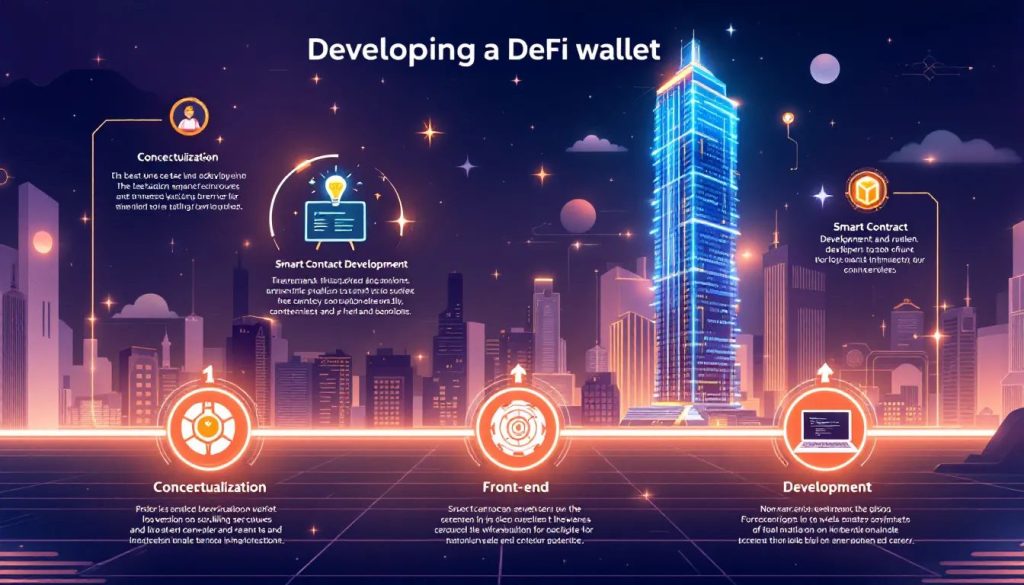Building a DeFi wallet involves creating a secure platform that allows users to maintain full control over their assets through private key management, eliminating the need for intermediaries. This self-custody approach ensures enhanced security and privacy for users. Developing an effective DeFi wallet requires a clear understanding of the target audience, adherence to legal regulations, and the integration of advanced features such as decentralized application (dApp) connectivity and cross-chain swap capabilities. Leveraging professional DeFi wallet development services can help streamline this process, ensuring the wallet is both secure and feature-rich.
Looking ahead, DeFi wallet development is evolving with trends like the incorporation of artificial intelligence to boost security, expanded cross-chain functionality to support diverse blockchain networks, and a strong emphasis on creating mobile-friendly interfaces for better user accessibility. These advancements, supported by expert DeFi wallet development services, aim to improve both the security and usability of DeFi wallets in the rapidly growing decentralized finance ecosystem.
Steps to Develop a DeFi Wallet

Creating a DeFi wallet requires key steps, beginning with pinpointing the intended users and establishing clear goals for the wallet. It’s important to grasp who will be utilizing the wallet and which functionalities they are seeking in order to deliver a product that satisfies their needs and distinguishes itself within the dynamic sphere of decentralized finance.
Adherence to legal requirements is also crucial. Making certain that the wallet complies with laws not only safeguards its creators, but also instills trust amongst users by allowing them to confidently handle intricate regulatory challenges. Addressing these complexities often necessitates methodical preparation and typically involves engaging with legal specialists.
The involvement of seasoned developers is imperative for producing a successful DeFi wallet. These experts contribute proven practices from within the industry as well as cutting-edge tech insights, guaranteeing that the wallet remains resilient, secure, and user-friendly. Their know-how proves invaluable when it comes down to incorporating sophisticated features which elevate both utility value and appeal of wallets.
Enhancements such as connectivity options for various dApps (decentralized applications) along with cross-chain exchange capabilities substantially raise both usability profiles & allure associated with DeFi wallets. Thus enabling straightforward interactions across numerous blockchain networks alongside diverse decentralized applications—thereby amplifying versatility while boosting ease-of-use factors significantly.
Lastly, comprehensive testing coupled with thoughtful launch tactics form critical components involved here too: exhaustive testing regimes ensure security measures remain steadfast plus confirm operability matches expectations precisely while strategic deployment approaches ensure effective engagement occurs directly aimed at primary consumer groups targeted initially. Thus when adhered strictly throughout development processes undertaken collectively, it allows builders ultimately unveiling not just products rich in feature-set composition but equally reliable regarding safety protocols complimented by adherence satisfying compliance norms effectively without fail.
Security Measures for DeFi Wallets
In the DeFi wallet landscape, ensuring top-notch security is critical. It’s imperative to adopt strong security measures, including end-to-end encryption and multi-party computation, to protect user assets effectively. The utilization of high-grade encryption techniques like AES-256 for private keys acts as a robust defense against any unauthorized access attempts.
The role of hardware wallets in elevating DeFi wallet security cannot be overstated. These specialized devices offer offline storage for private keys, insulating them from online vulnerabilities and minimizing hacking risks. Leveraging hardware wallets as part of the solution solidifies this layer of defensive protection.
Employing authentication safeguards such as multi-factor authentication (MFA) and behavioral biometrics is essential in thwarting unwarranted access. MFA ensures that users are required to confirm their identity through various means (greatly enhancing both security strength and identity verification processes), while behavioral biometrics scrutinize patterns in user activity for added safety.
Continual software updates are necessary to tackle emerging threats by patching up newfound weaknesses promptly, thus preserving the secure status quo of the wallet. Using trusted communication protocols like TLS/SSL guards data being transferred against eavesdropping or manipulation attacks.
Lastly but importantly, tangible protective strategies such as cold storage options or paper wallets hold significant value when it comes to securing large cryptocurrency sums. Cold storage shields digital assets from cyber hazards by keeping them offline, whereas paper wallets necessitate meticulous safeguarding against potential physical misplacement or theft scenarios—collectively providing peace of mind knowing that valuable assets remain safe within secured DeFi platforms.
Integration with DeFi Protocols
DeFi wallets, when paired with decentralized finance protocols, provide an entry point to a plethora of financial possibilities within the broader financial system. These wallets enable users to borrow, lend, and trade directly without needing intermediaries while maintaining total control over their tokens.
With DeFi wallets at their disposal, users find it effortless to interact with numerous decentralized finance apps. They can efficiently manage their assets across different dApps, engage in transactions on decentralized exchanges (DEXs), and tap into an extensive array of financial services—all encapsulated within a single defi ecosystem accessed via the wallet app.
DeFi wallets come equipped with yield farming and staking features that pave the way for users to generate passive income from their holdings. By joining liquidity pools or by staking tokens as they contribute liquidity to these pools—users stand as beneficiaries of additional income streams simply by allowing their assets employment in such productive roles.
The capacity for a wallet to support various blockchain networks through cross-chain functionalities is critical for user-friendliness. This multi-chain compatibility ensures smooth transitions and interactions amongst diverse blockchains networks thereby amplifying the wallet’s utility.
Lastly, ensuring that DeFi wallets deliver an intuitive user experience is indispensable for mass adoption. The emphasis lies on crafting interfaces that are straightforward along with guaranteeing uncomplicated integration between Defi protocols—a combination which streamlines entering into decentralised finance spaces while extending rapid access paths inclusive of all necessary features potentially accessible even through browser extensions thus composing complete packages catered toward accessibility within this innovative sector.
Future Trends in DeFi Wallet Development

Decentralized finance (DeFi) wallets are poised for significant growth, with a number of emerging trends shaping their development. The application of Artificial Intelligence (AI) is set to revolutionize both security and the user experience by promptly identifying and mitigating fraudulent activities.
Interoperability through cross-chain functionality is anticipated to become crucial, allowing smooth transactions across various blockchain networks. This adaptability will significantly enhance the convenience for users and propel DeFi wallet adoption forward.
Anticipate improvements in security features, prompted by technological advancements coupled with heightened demand from users. Such developments will play a pivotal role in ensuring that DeFi wallets maintain an ironclad defense against sophisticated threats while safeguarding user assets reliably.
The continued expansion of decentralized finance along with tech innovations spurs ongoing innovation within the realm of DeFi wallets. With more individuals turning towards DeFi platforms, there exists an escalating need for advanced yet intuitive wallets that cater to this burgeoning market segment.
Lastly, developers are concentrating on refining mobile applications and prioritizing user-friendliness within upcoming wallet designs. By making it easier for devices to access these financial tools seamlessly on-the-go, such strides in accessibility stand not only to bolster usability but also facilitate broader integration into everyday use cases—thereby bringing decentralized finance closer than ever before to mainstream acceptance.
Summary
DeFi wallets are transforming the management of digital assets by offering unprecedented autonomy and security. It’s essential for individuals who wish to explore decentralized finance to grasp the core aspects of DeFi wallet creation, including managing private keys and implementing robust security protocols.
With a promising outlook on DeFi wallet advancement that encompasses potential developments like AI integration and cross-chain functionalities, staying current with these advancements enables users to enhance their financial prospects while safeguarding the security and effectiveness of their digital assets.



 Bitcoin
Bitcoin  Ethereum
Ethereum  Tether
Tether  XRP
XRP  USDC
USDC  Lido Staked Ether
Lido Staked Ether  TRON
TRON  Cardano
Cardano  Avalanche
Avalanche  Toncoin
Toncoin  Wrapped SOL
Wrapped SOL